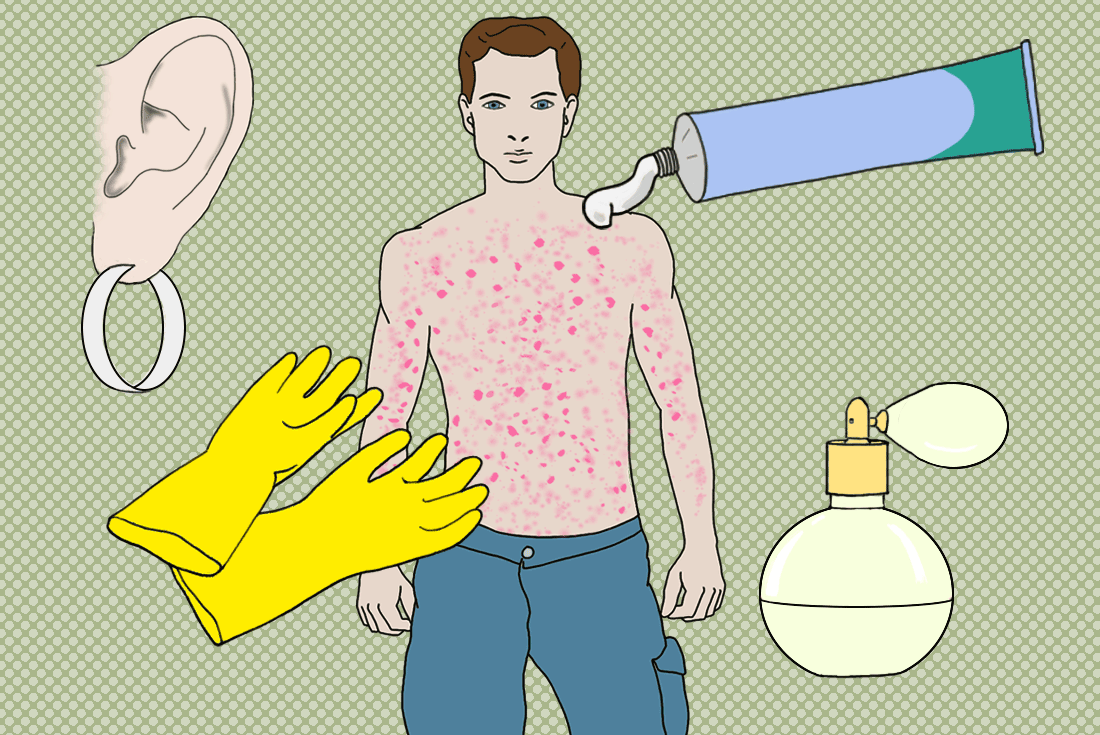ECZEMAS AND DRUG HYPERSENSITIVITY
3.5
Contact allergens
Contact allergens are quite different with regard to allergens causing immediate type reactions. They are usually small molecules – called haptens – which connect to proteins to become a complete antigen within the affected individual’s body. Contact allergens encompass metals, fragrances, preservatives, rubber chemicals, topical drugs, or plant-derived substances.
In allergic contact dermatitis, contact allergens elicit a specific immune response. Contact allergens are mostly small molecular compounds, so-called haptens. Most common are metals, such as nickel, cobalt, chromium, palladium, and – nowadays rarely – mercury. Fragrances present another large category, and further there are preservatives, used to prevent microbial overgrowth in products. These two are widely present in cosmetics, household products, and in certain occupations. And natural products such as balm of Peru, colophony or rosin, propolis, and tea tree oil may cause allergic contact dermatitis. On the other hand, primin from the flower Primula obconica, a contact allergen that occurred among gardeners and florists, has become very rare. The main types of contact allergens are described below. For each group, products and compounds which frequently contain these allergens are listed.

Several contact allergens exist.
In irritant contact dermatitis, physical and chemical irritants such as plain water, soaps, mild alkali and acids, use of solvents, heat, and cold dry air are common elicitors.
In atopic dermatitis, irritants as well as food and some respiratory allergens are important triggers. Contact allergy may play a role, particularly through the long-term use of topical treatments in atopic dermatitis.
Metals
High quality solid metal alloys and elementary metals do not cause contact allergy. If, however, metal ions are released, these may act as haptens. Nickel is the metal which most commonly causes contact allergies. It occurs in jewelry, buckles and clasps of clothes or shoes, coins, keys, or cell phones. Cobalt is present in cosmetics, dyes as well as in many metal alloys. Chromium occurs in stainless steel, cement or is used for tanning of leather goods. Mercury has been widely used in disinfectants but is now banned for ecological reasons in most countries.
Fragrances
Fragrances are the second most common group of contact allergens. Fragrances are difficult to avoid because they are not only present in perfumes and cosmetics but also in skin care products, such as liquid soaps, shampoos, and wash powders. Cross-reactivities with essential oils and natural products (eg colophony and balm of Peru) may occur.
Preservatives
Preservatives are added to many cosmetic and body care products and are also widely used in occupational settings. They are added to prevent deterioration of creams and lotions and have an inherent chemical reactivity. Unfortunately, they may also bind to skin proteins and thereby complex to build complete antigens. Formaldehyde and formaldehyde releasers as well as parabens have been used for a long time for this purpose. Newer substances include compounds such as dibromdicyanobutane or isothiazolinones.
Rubber chemicals
Rubber chemicals are agents (eg thiurams and carbamates) which are added to natural rubber to prevent aging and brittleness. They may cause contact dermatitis by direct contact with products such as gloves, rubber handles, or masks. Contact allergies to these chemical agents should be distinguished from allergies to natural rubber (ie latex), which is an IgE-mediated allergic reaction to latex proteins present in natural rubber.
Topical drugs
Some topical drugs may cause sensitization (eg topical emollients, disinfectants, antibiotics, local anesthetics or anti-inflammatory agents, and even rarely some anti-inflammatory corticosteroid molecules). Particularly patients with chronic eczemas might apply such products (on a damaged skin barrier) during longer time periods and may therefore get sensitized more easily.
Plant-derived substances
Rosin (colophony), balm of Peru, and propolis are derived from natural sources and contain a variety of different agents. Rosin is used as glue. Balm of Peru is present in many topical products and may cross-react with some fragrances in perfumes. Propolis is used as topical medication as well as tea tree oil. In the USA poison ivy is an important cause of severe allergic contact dermatitis.
License
University of Basel
